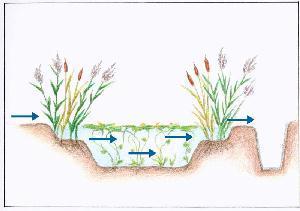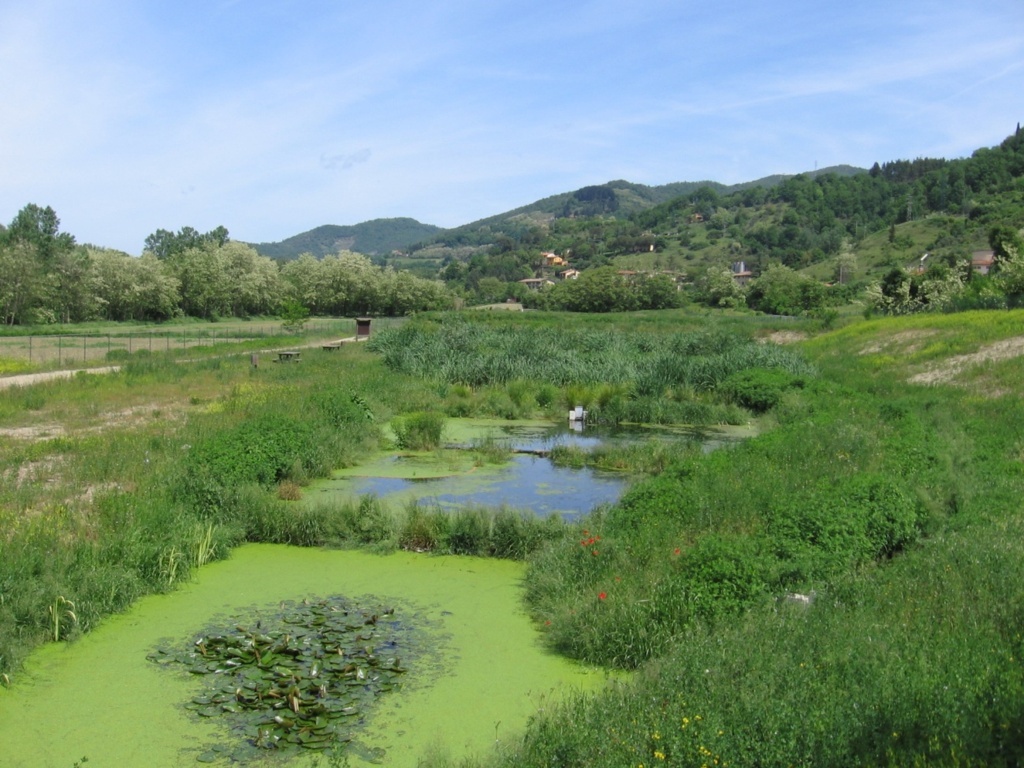Free water surface flow (FWS)
Free water surface (FWS) flow constructed wetlands is, among nature-based wetland solutions for wastewater treatment, the most "natural", since it's functioning is the nearest to natural wetlands and exploit as much as possible their ecosystem services; FWS systems adopt a shallow water depth directly connected to the atmosphere and are more suited for lightly polluted wastewater (e.g. tertiary treatment), or creation of biofilter area with a high naturalistic value. The use of different water depths allows the use of a wide range of plants, with plantation of both emerging and floating macrophyte.

More information
Free water surface (FWS) systems consist in basins or channels where the water surface is exposed to the atmosphere and the soil, constantly submerged, constitutes the support for the roots of the emerged plants; the water flow is horizontal and the height of basins is generally limited to a few tens of centimetres, except for some deep zones. FWS is the most suitable wetland solution to maximize the ecosystem service of biodiversity increase, since they implement different conditions in which several aquatic plants can be placed, from emergent to floating Macrophytes, as well as producing differentiated habitat for several florae and fauna species.

Example of a free water surface system - Polishing stage of the constructed wetland WWTP of Dicomano (3500 PE), designed by IRIDRA
Removal processes
In these systems removal mechanisms reproduce exactly all characteristics of the natural self-depuration capacity of wetlands. The list of the processes occurring in FWS wetlands and the target contaminant are following reported.
| Removal mechanisms |
|||
| Physical | Chemical | Biological | |
| Suspended Solids |
Sedimentation | - | Microbial processes |
| BOD5 | Sedimentation | UV Radiation | Microbial processes |
| COD | Sedimentation | UV Radiation | Microbial processes |
| Metals (Ag, As, Cd, Cu, Cr, Hg, Ni, Pb, Se, Zn) | Sedimentation | Precipitation, Sorption, ionic exchange | Root uptake, Aerobic reduction |
| Hydrocarbons | Volatilization | UV Radiation | Microbial processes, Root uptake |
| Hydrocarbons from synthesis (solvents, pesticides, IPA, chlorinated hydrocarbons) | Sedimentation |
Sorption, Radiazione UV |
Microbial processes, Root uptake |
| Nitrogen | Sedimentation | Sorption, Volatilization (ammonia nitrogen) | Microbial processes, Bacteria uptake, Root uptake |
| Phosphorus | Sedimentation | Precipitation, Sorption | Bacteria uptake, Root uptake |
Removal processes occurring in FWS systems (Wallace et al., 2006)
References
Wallace S.D., Knight R.L. (2006), “Small-Scale Constructed Wetland Treatment Systems”. IWA Publishing, London

